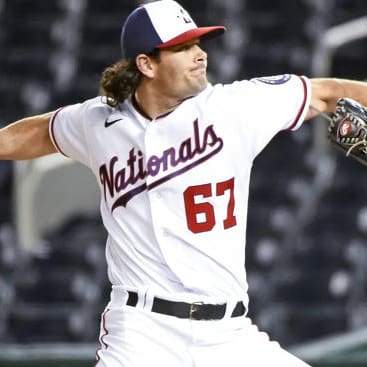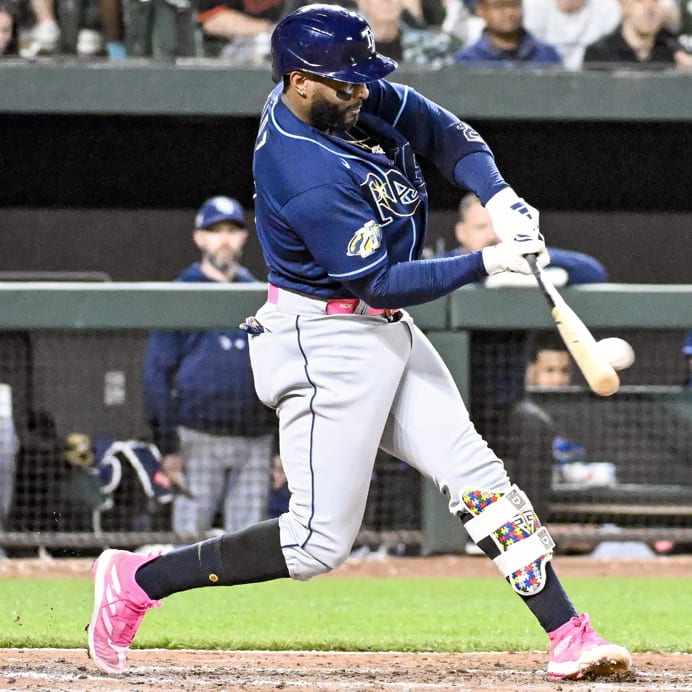This article is part of our The Z Files series.
I need to start with an apology. This week's missive is on keeper league philosophy and targets. There was a time this would be timely. However, the recent trend has been for rebuilding teams to hold their fire sale earlier and earlier each season. As such, I'm sorry, I should have written this a few weeks ago. That said, many leagues have also extended their trade deadline past July 31, so there could be an ample audience for what follows.
This discussion assumes an auction keeper league, though the thought process extends to draft formats. Let's start with my approach to rebuilding, as it's unconventional. Many target cheap, single-digit salary keepers. I prefer to freeze moderate and high-priced players, saving my cheap players for the end-game. After accounting for inflation, if you're patient and have a good sense for auction dynamics, you can assemble a roster with higher scoring potential starting with a higher-priced keeper base. I'll have my equivalent of $1 and $2 keepers, the difference being I'm drafting them, not trading for them now.
The other factor making this work is I'm willing to pay for the pricier keepers. I understand the calculus. Not only do I need to compensate you for rest-of-season performance, but also keeper potential. The advantage here is since I'm only likely to pry away a couple of keepers of this ilk, I can package a whole lot of present day production to get my guy(s). I'd rather protect fewer than the minimum, so
I need to start with an apology. This week's missive is on keeper league philosophy and targets. There was a time this would be timely. However, the recent trend has been for rebuilding teams to hold their fire sale earlier and earlier each season. As such, I'm sorry, I should have written this a few weeks ago. That said, many leagues have also extended their trade deadline past July 31, so there could be an ample audience for what follows.
This discussion assumes an auction keeper league, though the thought process extends to draft formats. Let's start with my approach to rebuilding, as it's unconventional. Many target cheap, single-digit salary keepers. I prefer to freeze moderate and high-priced players, saving my cheap players for the end-game. After accounting for inflation, if you're patient and have a good sense for auction dynamics, you can assemble a roster with higher scoring potential starting with a higher-priced keeper base. I'll have my equivalent of $1 and $2 keepers, the difference being I'm drafting them, not trading for them now.
The other factor making this work is I'm willing to pay for the pricier keepers. I understand the calculus. Not only do I need to compensate you for rest-of-season performance, but also keeper potential. The advantage here is since I'm only likely to pry away a couple of keepers of this ilk, I can package a whole lot of present day production to get my guy(s). I'd rather protect fewer than the minimum, so long as they fit my criteria, as opposed to keeping the maximum number of players allowed. There's an opportunity cost to freezing a player. In many instances, I trust my ability to fill that roster spot with more potential in the auction.
The type of players I go after are those whose cost this season is less that what I expect them to cost nest year. I know, not very enlightening. Here's the catch. There needs to be a logical reason they may be available. Perhaps there's an injury risk or a breakout performance that may not be sustained. Maybe there's a chance the playing time will be lessened, such as with a younger pitcher. Though, sometimes, a player is traded to a contender into a different role, but next season they're likely to return to the previous role with higher-scoring potential.
Many of these players have been discussed in this space the past month. A couple will be tough sells, requiring creative negotiations. Maybe their owner isn't interested in moving them. Fine, move to the next target on your list.
Jose Ramirez, Cleveland Indians: May as well begin with the least likely to be available. Ramirez fits the criteria of next year's cost dwarfing this season's price tag. Well, maybe not dwarfing, but his ADP will certainly be earlier next spring. The angle here is while Ramirez contributes in homers, he's not a slugger. Offers a couple of bona fide power hitters, perhaps doing the category math, illustrating how your package of bats will yield more points than Ramirez and whoever they upgrade. Obviously, we're taking huge names, something like Anthony Rizzo and Robinson Cano, a couple of batters that didn't go at a discount in the spring. Or maybe, if you have Jose Altuve and your pitching tanked, you deal Altuve and Khris Davis, something like that.
Marcell Ozuna, Miami Marlins: First, a quick note about the Marlins, as they're one of seven teams that have yet to play 100 games as of Thursday's schedule. Ozuna hits near the top of the order and hardly ever sits, meaning he could get 15-20 more plate appearances than other hitters. This may not seem like much, but with only nine-plus weeks left, it's significant. With respect to his availability, point out he's fanning more than last season, which could result in a late season slump at the most inopportune time. Suggest he's never hit .300 before and that his batting average on balls in play (BABIP) is a candidate to regress. Finally, question his durability. He's only played more than 150 games once.
Of course, all this begs the question, "Why do I want to trade for him?" Ozuna's hard contact is at a career high level and while there's no guarantee he repeats it next season, I think his baseline is higher. That said, he's more aggressive this season, swinging a little more both in and out of the zone. Perhaps this aggressiveness is fueling the harder contact. I'd just be more comfortable if he was less aggressive outside the zone. That said, for some hitters, the strike zone is arbitrary. I don't mean arbitrary in terms of umpire judgment, but rather some pitches off the plate are still in the batter's wheelhouse. All this said, what I like most about Ozuna is barring injury, he should be among the league leaders in plate appearances in future seasons, and there's no reason to be concerned about his health.
Jonathan Schoop, Baltimore Orioles: Schoop's my favorite target on this list. His power has never been questioned, but he's never been much of an average hitter. This season, he's whiffing at his usual clip. The bump in average is from a spike in BABIP. There's always a concern whether that will carry over, but I like the increase in hard-hit rate as well as a few more line drives. As opposed to Ozuna, Schoop's chase rate is down, lending some credence to the idea the improvement is real. The catch is where he'll hit in a healthy Orioles lineup. He's been batting third of fourth with players like Chris Davis hurt. I want Schoop as a keeper now since regardless where he hits, it'll be worth his current salary. However, next season, if it appears he'll be batting in a top five spot, I'll be all over Schoop.
Miguel Sano, Minnesota Twins: Many of the general points have been covered with the first three players, so the rest of the descriptions will be shorter. The reason I want Sano is I envision him as a run-producing machine and not just a power hitter. Runs and RBI are often overlooked by those using a more subjective ranking process whereas those are captured, and accounted for, in a more spreadsheet-driven ranking. As for why he could be available, he still strikes out a bunch, making a slump possible down the stretch.
Didi Gregorius, New York Yankees: I'm a numbers guy, but I do have a couple of anecdotal leans when analyzing hitters. Hitters, especially middle infielders coming up with an all-glove no-stick reputation, pique my interest. Often, one of the characteristics of a strong fielder is excellent hand-eye coordination. This can translate into better contact. If the hitter has any modicum of strength, this can also result in more power. Gregorius fits this model perfectly, plus he plays in the perfect park for his skills.
Scott Schebler, Cincinnati Reds: Of all the players discussed, Schebler was closest to not making the list. I'm just not convinced he's a surefire regular next season. Maybe the approach is to target him in NL-only formats and not mixed leagues. His average is still suspect, but the power is real. In fact, suggesting he could lose playing time to Jesse Winker down the stretch could be the opening to pry him loose.
Nick Castellanos, Detroit Tigers: By this time, you likely know the deal. Castellanos hits the ball really hard but doesn't have the results to show for it. Some of that is hitting too many grounders that are easily defensed. I just see a guy that, with a slight adjustment, could be a monster. During the spring, it appeared he would join the growing crowd of altering his swing path to be of the uppercut variety. With another off-season to tweak, I'm willing to take the chance Castellanos makes the necessary adjustments.
Alex Wood, Los Angeles Dodgers: Let's finish with some pitchers. The selling point with Wood is innings, especially in head to head formats. The Dodgers are likely to monitor Wood's workload down the stretch, with only home-field advantage to play for. I can't imagine there will be any thoughts of returning Wood to the bullpen.
James Paxton, Seattle Mariners: With Paxton, it's all about health. Truth be told, there's no guarantee he's healthy next season. However, his 2017 cost is worth the chance. You'll need to offer an ace arm, and likely some hitting to make it happen, but there's a chance Paxton's owner prefers a healthy arm to make the championship run.
Aaron Nola, Philadelphia Phillies: Nola will be a real tough sell since health isn't as much of an issue, and there's no obvious need to curtail his innings. That said, he's still the Phillies ace so he may be shut down in September. Seven more starts gets him in the 150 innings pitched range, which means there shouldn't be any restriction next season. I don't think it will happen, but if you can offer someone like Carlos Carrasco or Madison Bumgarner along with upgrades elsewhere, Nola's offer may prefer knowing their hurler will finish the season. I suppose saying Nola's wins potential is low with the Phillies, but he's won five of his last seven starts, so this is a borderline strawman argument.
Luis Severino, New York Yankees: I'll be honest, I have no idea how to spin Severino other than to overpay. That's how much I like his prospects for the next few seasons. I love his composure, approach and obviously stuff. I'm not concerned at all about Yankee Stadium or just pitching in New York. Basically, I let Severino's owner know I'm willing to give up whatever it takes.
Jimmy Nelson, Milwaukee Brewers: A whole lot of us were a year early on Nelson in 2016. However, last season's disappointing campaign is the soft spot needed to loosen the grip of his owner. The spin is, "Wouldn't you prefer someone with a better track record?" Obviously, you need to have a pitcher fitting that description, but if you do, Nelson is no doubt cheap and while he'll likely regress next season, the landing point should still yield a positive return on investment.










